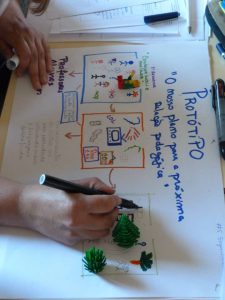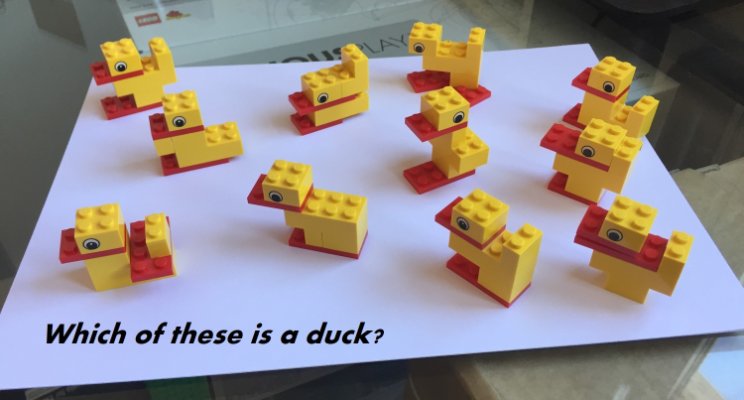Christopher Shamburg wrote a great blog post about creativity and limits.
Have you ever been asked to do something creative and blanked out? Or worse, have you ever asked a students to create, write, or make something original and get little to no work? The imperative “Be Creative!” seems to have the opposite effect.

Now consider the idea of creative constraints. The paradox that we can be more creative with less material. The concept of creative constraints is that innovation and creativity can be fostered with limits. Give kids six legos, three crayons, or a limit of 17 syllables, and you’ll get something. Think of the success of online memes such as Six Word Stories, where authors are challenged to create a narrative in six words, and Post Secret, where people compellingly bare their souls on a postcard.
Creative Constraints is a fundamental principle of creative mediums such as painting and poetry (think of the constraints of a sonnet or haiku), but there are business applications as well. Marissa Mayer, CEO of Yahoo loves it as a creative tool for employees. It’s been discussed as an effective management tool, a tool for architects and award-winning professionals, and there is psychological and social research on its effectiveness.
Here are five benefits to teaching with creative constraints
Prompts and Scaffolding–giving student a limited set of of materials (components, time, words, artifacts) forces them to deeply look at the affordances of these item, and see where they lead.
Clarity–once you define the limits or challenge, there’s no need for complex directions or further explanations. It’s easy to understand, explain, and assess. Some students will find a ‘workaround’ but that’s innovation.
Cognitive Flexibility–Students doing their project is an initial learning experience; students who see the varied creations of others is extremely powerful. It opens up a sense of possibilities when they were initially confronted with limits. Students can remain proud of their work, but often marvel at the unique directions that others took the work.
Systems Thinking–Most work and human activity is situated in a system, and systems thinking has been identified as a key 21st century skill. Treating constraints intentionally develops the mindset of systems thinking.
Flow–this is more opinion than characteristic, but I have noticed that student engagement is higher on work and projects based in creative constraints. It’s quicker from them to take ownership, encourages enough of a ‘similar experience’ to keep a sense of community, but allows enough creativity for their individual points of view.
Teaching with Creative Constraints
Asking students to solve a problem is a case study or starting a research project with a limited set of resources are two common applications of teaching with creative constraints. Below are two specific examples from my teaching with technology and language.
Six Sounds in Search of an Author
When I teach people (from 4th graders to teachers) how to use audio editing software–effectively and creatively, I give them the “Six Sounds Project” where they have to make a one-minute story that uses six sounds: engine, crickets, splash, match strike, heartbeat, and a phone ring.
Three-Minute Epic
I also worked with some teachers from Beverly MA to develop an engaging way to teach the Odyssey with technology–we came up with the “Three-Minute Epic“, a way to focus student on the concept of the epic hero, epic simile, and connect the bricolage-like process of the oral tradition with 21st century mindsets. Student have a set of material (pictures, sounds, extended similes) and have to create a story of a journey with them.
Note the photo above– according to Lego Education you can make over 900,000,000 combinations with six 8-studded Legos.
Christopher Shamburg, Ed.D. is a Professor in the Educational Technology Department at New Jersey City University and Coordinator of the Doctorate in Educational Technology Leadership. He is the author of several books on educational technology and his professional interests focus on the applications of technology to improve learning and performance. Email him at cshamburg@njcu.edu or visit his web page.
Works Cited
Lenrer, J. (2013) Need to create: Get a constraint. From Wired Magazine Online, retrieved November 10, 20013 from http://www.wired.com/wiredscience/2011/11/need-to-create-get-a-constraint/
May, M. (2013). How intelligent restraints drive creativity. From Harvard Business Review Blog Network, retrieved November 12, 2013 from http://blogs.hbr.org/2013/01/how-intelligent-constraints-dr/
Meyer, M. A. (2006). Creativity loves constraints. From Business Week Online, retrieved November 10, 2013 from http://www.businessweek.com/stories/2006-02-12/creativity-loves-constraints
Sturt, D. (2013). Creativity: How constraints drive genius. From Forbes Online, retrieved November 14, 2013 from http://www.forbes.com/sites/groupthink/2013/07/12/creativity-how-constraints-drive-genius/








 Become a LEGO Serious Play facilitator - check one of the upcoming training events!
Become a LEGO Serious Play facilitator - check one of the upcoming training events!